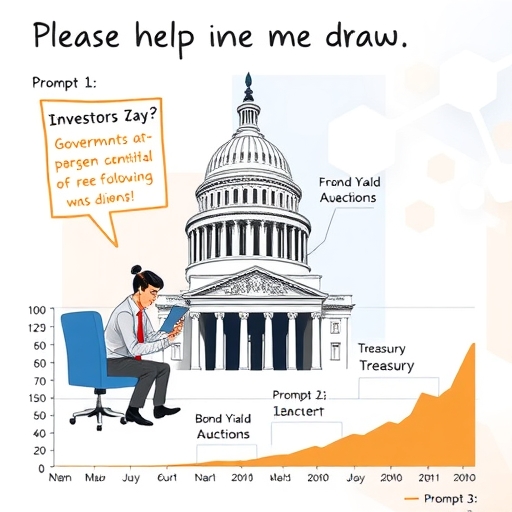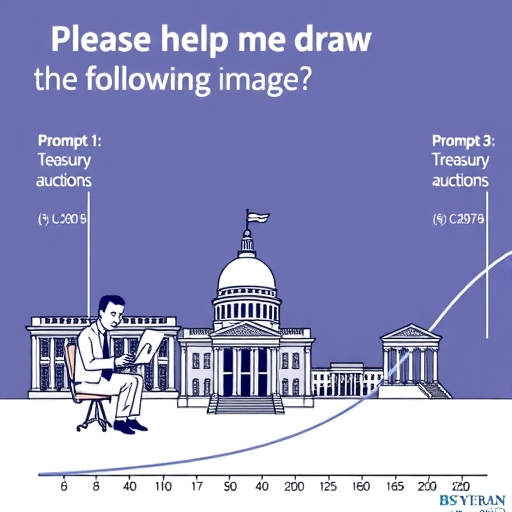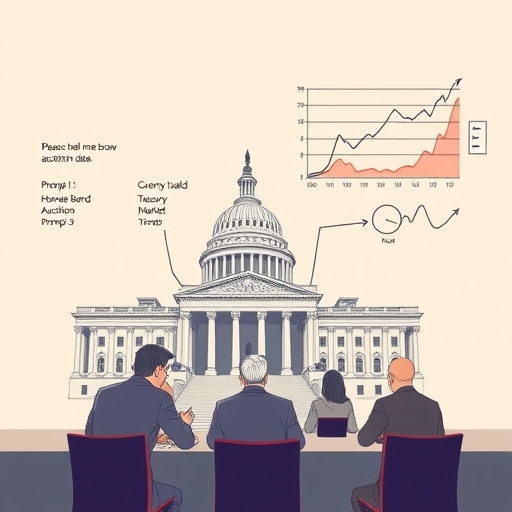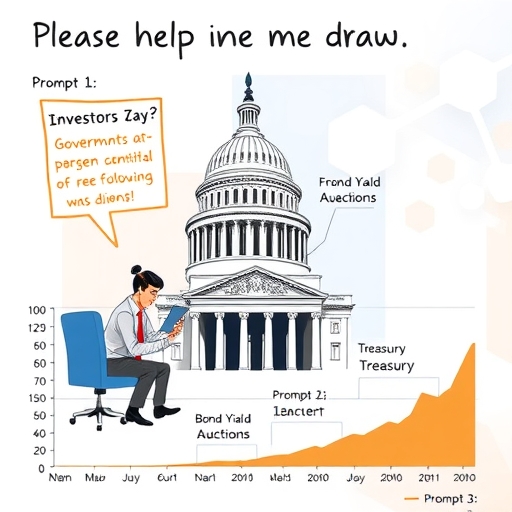Unpacking Treasury Bond Auctions: A Deep Dive into Investor Sentiment and Market Signals
Welcome, fellow explorers of the financial markets! Today, we’re embarking on a journey into a fascinating, often overlooked, yet critically important corner of the global economy: **Treasury bond auctions**. Think of these auctions not just as technical procedures, but as pulsating indicators of investor confidence, government health, and the overall direction of interest rates. For anyone looking to truly understand the engine room of the bond market, or even just trying to make sense of why yields move, deciphering these events is a must.
We’ll explore what these auctions are, how they function, and most importantly, how their results provide invaluable clues about market sentiment, government borrowing ability, and macroeconomic expectations. Whether you’re an investor just starting to build your portfolio or an experienced trader refining your technical analysis, understanding bond auctions adds a crucial layer to your market literacy. So, let’s dive in and unlock the secrets held within these seemingly complex events.
- Treasury bond auctions serve as indicators of market sentiment.
- The process of a bond auction involves multiple types of bids from various investors.
- The results of an auction can influence broader economic indicators such as interest rates.

Understanding Bond Auctions: The Bedrock of Government Financing
At its core, a **bond auction** is simply the process by which governments sell their debt securities (like bonds and notes) to investors. When a government needs to raise money to fund its operations, pay existing debts, or invest in infrastructure, it issues bonds. These bonds are essentially IOUs, promising to pay back the principal amount (the face value) on a specific date in the future (the **maturity date**), and usually making periodic interest payments (coupon payments) along the way.
Why are these auctions so significant? Because they are the primary mechanism through which governments like the U.S. Treasury or Iceland’s Government Debt Management borrow money. The demand for these bonds, and the yields at which they are sold, are direct reflections of how the market perceives the government’s creditworthiness and the broader economic outlook. High demand allows the government to borrow more cheaply (at lower yields), while weak demand forces them to offer higher yields to attract buyers, increasing the cost of borrowing.
| Term | Description |
|---|---|
| Maturity Date | The date on which the principal amount is repaid. |
| Coupon Payments | Periodic interest payments made to bondholders. |
| Yield | The return an investor will receive on a bond. |
For us as investors, this process is critical because the yields set at these auctions influence interest rates across the entire financial system, from corporate bonds and mortgages to car loans and credit cards. They serve as powerful **benchmark interest rates**. So, when we see headlines about Treasury auction results, we’re not just looking at abstract numbers; we’re seeing signals that affect the cost of money for businesses and individuals alike.
The Mechanics: Navigating the Treasury Auction Process
How does a Treasury auction actually work? While the specifics can vary slightly between countries, the general process follows a structured path. The U.S. Treasury, for instance, regularly announces auctions for various debt instruments, including short-term bills, medium-term notes, and long-term bonds. These announcements specify the security being offered (e.g., 10-year notes, 30-year bonds), the amount being sold, and the key dates: the announcement date, the auction date, and the **settlement date**, which is when payment is due and the bonds are delivered electronically to the buyers.
Investors participate by submitting bids, typically through primary dealers (large financial institutions authorized to buy directly from the government). There are two main types of bids:
- Noncompetitive Bids: These are usually submitted by smaller investors or institutions. The bidder agrees to accept the yield determined by the auction’s results for the competitive bids, up to a certain maximum amount. These bids are always accepted in full, up to a certain cap, ensuring these participants get the amount they want at the market-clearing price/yield. The results for noncompetitive auctions are often released slightly before the competitive auction closes, offering an early peek at some level of demand.
- Competitive Bids: These are submitted by larger institutions, like banks, mutual funds, and foreign central banks. These bidders specify both the amount of bonds they want to buy and the yield they are willing to accept. The Treasury then accepts bids starting from the lowest yield (highest price) upwards until the total amount offered is sold. All competitive bidders whose bids are accepted receive the highest yield (lowest price) of the accepted competitive bids – this is known as the single-price auction format, used by the U.S. Treasury to encourage more aggressive bidding.

The difference between the total amount bid by investors (demand) and the amount of debt offered by the government (supply) is a key indicator. We’ll explore this further when we discuss the **bid-to-cover ratio**. Accessing results for both Noncompetitive and Competitive auctions is typically made available shortly after the auction closes, allowing the market to react quickly to the outcome.
Even in other contexts, like the Icelandic bond auctions mentioned in our source material, similar procedures apply. For example, the announcement of an upcoming auction for specific Treasury bond series (like RIKB 28 1115 and RIKB 38 0215, identified by their ISINs IS0000028249 and IS0000037265) clearly lays out the auction date (June 20, 2025), time (10:30 am – 11:00 am), maturity dates (November 15, 2028 and February 15, 2038), settlement date (June 25, 2025), and payment deadline (14:00 on Settlement Date). Details like a 10% additional purchase right under General Terms of Auction are also specified, highlighting the precise procedural nature of these events.
Decoding Auction Results: Yield, Bid-to-Cover, and Investor Appetite
The immediate aftermath of a bond auction provides crucial data points for market participants. The two most closely watched metrics are the **high yield** and the **bid-to-cover ratio**. Let’s break these down.
- High Yield: This is the highest yield among the accepted competitive bids. It essentially represents the effective interest rate the government will pay on the debt sold at that auction. A lower high yield means the government borrowed money more cheaply, suggesting strong demand or favorable market conditions. A higher high yield indicates weaker demand or that investors require more compensation (a higher return) to hold that debt, perhaps due to perceived higher risk, inflation expectations, or alternative investment opportunities.
- Bid-to-Cover Ratio: This ratio tells us how many dollars of bids were received for each dollar of bonds offered. It’s calculated by dividing the total amount of competitive bids received by the amount of bonds sold. A bid-to-cover ratio greater than 1 indicates that demand exceeded the amount offered. A higher bid-to-cover ratio signifies stronger demand. For example, a ratio of 2.68 means investors bid for $2.68 worth of bonds for every $1 offered. Comparing the latest ratio to previous auctions or a historical average gives us context on whether demand is strengthening or weakening.
| Metric | Description |
|---|---|
| High Yield | The highest yield of bonds accepted during the auction. |
| Bid-to-Cover Ratio | The ratio of total bids to total bonds offered, indicating demand strength. |
Think of it like an open market sale: if many buyers want a limited number of items, the price goes up (and for bonds, yield goes down). If there are few buyers, the seller has to lower the price (or offer a higher yield on the bond) to find takers. These numbers – the high yield and the bid-to-cover ratio – are the market’s instant assessment of the government’s ability to finance its debt and a real-time gauge of **investor appetite** for that specific maturity.
Recent US Treasury Auctions: A Closer Look at Shifting Signals
Let’s turn our attention to some recent U.S. Treasury auction results, as detailed in our source analysis, which offer a clear illustration of how these metrics are interpreted and how they reflect market sentiment. The focus has been particularly on the longer-duration bonds, often seen as more sensitive to changes in long-term economic outlook and fiscal health.

A recent $22 billion auction of **30-year bonds** was perceived quite positively by Wall Street. The bonds settled with a yield around **4.84%**. Why was this seen as positive? Because it suggested solid buying interest and strong demand at that yield level. The outcome eased some concerns that had been building about the market’s willingness to absorb large amounts of long-term U.S. debt, especially given the backdrop of rising federal deficits. It contributed to what analysts described as a relief rally in bonds, where prices rose and yields fell after the auction results were released.
However, the picture hasn’t been uniformly strong across all maturities. For instance, a **20-year bond auction** held shortly before the successful 30-year sale saw above-average demand relative to its historical track record, with a **bid-to-cover ratio of 2.68** compared to a 10-auction average of 2.55. This might sound good, but when compared to the *previous month’s* 20-year auction ($16B sold), which had a bid-to-cover of 2.46 but settled at a higher yield of 5.047%, the picture becomes more nuanced. The recent auction’s high yield was 4.942%. While demand was technically “above average” historically, some comparisons to very recent auctions showed potentially less strength than initially met the eye, highlighting the importance of looking at multiple data points and recent trends, not just historical averages in isolation.
Similarly, the previous **10-year Treasury auction** also reportedly saw strong demand, indicating continued solid interest in this key benchmark maturity. The varying strength across different maturities (strong 30-year and 10-year, slightly less enthusiastic 20-year compared to prior month) tells us that investor sentiment isn’t monolithic; it can differ based on the specific characteristics and perceived risks of each bond type and its maturity horizon.
Investor Demand: Why the Recent Strength, Especially from Abroad?
Digging deeper into the sources of demand provides further insight. A particularly notable aspect of the recent strong 30-year auction was the significant participation from **foreign investors**. Our analysis highlights that foreign buyers purchased **65.2%** of the 30-year bonds sold in that auction. This figure is not only a substantial majority but also marks the strongest foreign demand seen since January and is near the 1-year average. This compares favorably to the **58.9%** foreign participation in the previous month’s 30-year auction.
Why is strong foreign demand so crucial? Foreign investors, especially central banks and large sovereign wealth funds, are major holders of U.S. debt. Their willingness to buy U.S. Treasuries is a key vote of confidence in the stability and safety of the U.S. as a borrower and its currency. Concerns about declining demand for U.S. Treasuries have been a recurring theme in market discussions, often linked to geopolitical factors, trade tensions, or concerns about the U.S.’s fiscal trajectory. A jump in foreign participation directly counters these worries, at least temporarily. It suggests that despite potential global uncertainties or domestic U.S. challenges, global investors continue to view U.S. Treasuries as a relatively safe and attractive asset, perhaps a **safe-haven** in uncertain times, or simply offering appealing yields compared to alternatives.
The solid results, bolstered significantly by international buyers, provided a confidence boost for those worried about a potential decrease in the market’s appetite for U.S. debt. It signaled that, for the time being, investors are not overly panicked by the ongoing federal budget negotiations or the rising deficit figures. This doesn’t eliminate the long-term concerns, which we will address shortly, but it suggests that in the immediate term, there is sufficient capital globally willing to fund U.S. borrowing needs at current market rates.
Connecting the Dots: Macroeconomic Tailwinds and Investor Calculus
Understanding the immediate auction results is important, but connecting them to the broader economic landscape provides the necessary context. Investor demand in bond auctions doesn’t happen in a vacuum; it’s heavily influenced by macroeconomic factors and expectations about future economic conditions, particularly interest rates and inflation.
Our analysis points to a crucial link between the recent strong auction demand and recent **inflation reports**. If inflation appears to be cooling or is expected to remain muted (perhaps suggesting **tariff** effects aren’t as inflationary as feared, as one view suggested), this increases the likelihood of the **Federal Reserve** (the U.S. central bank) implementing **rate cuts** later in the year. This expectation of lower future interest rates has a direct impact on investor behavior in bond markets.
Why? Because bonds purchased today offer a fixed yield for their duration. If you expect interest rates (and therefore potentially bond yields) to fall in the future, the yields available *today* become relatively more attractive. Investors are incentivized to buy bonds now to **lock in** these current, higher rates before they potentially decline. This increased buying pressure, driven by expectations of future Fed policy shifts, boosts demand in auctions, leading to higher prices and, consequently, lower yields on the bonds being sold. This is precisely what we saw happening, with yields falling across the day following the strong demand in the recent 30-year auction, settling around 4.84%, while the 10-year yield settled around 4.36%.
So, the strong demand wasn’t purely an isolated event; it was partly a consequence of investors positioning themselves based on their interpretation of recent economic data and their expectations for the Federal Reserve’s next moves. It highlights how central bank policy expectations are woven into the fabric of bond market dynamics and auction outcomes.
The Other Side of the Coin: Uneven Demand and Maturity Preferences
While the recent 30-year and 10-year auctions offered a degree of relief, it’s important to acknowledge that demand isn’t always uniformly strong across the yield curve. As noted earlier, the preceding 20-year auction, despite being “above average” historically, showed less robust demand compared to the prior month’s sale based on metrics like yield and the specific bid-to-cover comparison. This points to a broader pattern sometimes observed in the market: investors can have different preferences or levels of conviction depending on the bond’s **maturity date**.
Our analysis mentions that hesitancy has been observed among investors regarding **longer-duration bonds** (like 30-year bonds) recently. Why might this be the case, even with the recent successful 30-year auction? Uncertainty about the **long-term US debt burden** and future fiscal policy can make investors wary of locking up their capital for three decades. If the government’s fiscal position deteriorates significantly over that period, it could theoretically impact the perceived safety or relative value of those long-term bonds, even if the risk of outright default remains extremely low for U.S. Treasuries. This hesitancy might manifest as requiring a higher yield (a “term premium”) to compensate for that long-term uncertainty.
In contrast, **shorter-term Treasuries** (like the 10-year or shorter notes) have reportedly seen more robust demand. This could be because investors are more comfortable predicting the economic and fiscal landscape over a shorter horizon. Or, in a rising rate environment (or one perceived to be near peak rates before potential cuts), shorter-term bonds expose investors less to potential price declines if rates were to rise further, while offering relatively attractive yields compared to very short-term instruments like bills.
This divergence in demand across different maturities underscores that the bond market isn’t a single entity; it’s a complex ecosystem where different parts react differently to the same set of economic data and future expectations. Analyzing auction results across the yield curve provides a more complete picture of market sentiment.
Persistent Challenges: Deficits, Credit Ratings, and Long-Term Outlook
Despite the temporary relief provided by recent strong auctions, it would be remiss to ignore the underlying structural concerns that continue to cast a shadow over the long-term outlook for U.S. debt. Our analysis repeatedly emphasizes the persistent scrutiny on the **long-term US fiscal position** and the expected increase in **federal deficits**. These are not new concerns, having been noted for years, but current circumstances – large deficits, ongoing spending debates, and even events like a **credit rating downgrade** – amplify market focus.
Moody’s, one of the major credit rating agencies, downgraded the U.S.’s credit outlook (though not the rating itself at that specific time mentioned in the source, but the context implies a previous action or ongoing scrutiny) in May, explicitly citing the growing deficits and questioning the government’s ability to finance its obligations sustainably in the long run. Such actions by rating agencies serve as official warnings to investors globally and can negatively impact demand for a country’s debt, potentially forcing them to pay higher yields.
Furthermore, discussions around trade policy, such as the potential impact of **tariffs**, also play a role. As one view suggests, tariffs could potentially raise short-term inflation (requiring a higher yield premium to compensate for lost purchasing power) while simultaneously lowering economic growth (which could make alternative investments less appealing, potentially boosting bond demand). More significantly, they could cause **foreign investors** to question the U.S. debt’s status as a secure **safe-haven** asset if trade disputes escalate and impact financial stability or international relations. This complex interplay of fiscal policy, monetary policy expectations, trade dynamics, and creditworthiness assessments collectively influences the backdrop against which each Treasury auction takes place.
Therefore, while the recent auction results were encouraging, they don’t eliminate these fundamental concerns. They simply suggest that, at current yield levels and with the prevailing macroeconomic expectations (like potential Fed rate cuts), there is still sufficient market depth and investor willingness to absorb the issued debt, at least for now. The market remains sensitive to any signs that the fiscal situation is worsening or that demand is beginning to wane, particularly for longer-dated bonds which are most exposed to long-term fiscal uncertainty.
Navigating the Bond Market: Different Investor Perspectives and Strategies
In the face of these complex signals – temporary strong demand juxtaposed with long-term fiscal concerns – how do different investors approach the bond market, and specifically Treasury auctions?
Large asset managers and investment firms, like **Pimco (Pacific Investment Management Company)** mentioned in our analysis, often articulate specific strategies. Pimco, for example, has reportedly favored **shorter/medium duration bonds** (like 5-year or 10-year maturities) over **longer terms** (like 30-year). This preference might stem from the very uncertainties we discussed: less exposure to long-term fiscal risks and potentially better positioning for expected interest rate movements.
Other investors might look at the current yield levels – like the approximately 4.84% on the recent 30-year bond – and see them as genuinely attractive. For years after the 2008 financial crisis, bond yields were historically low. Current yields, while fluctuating, are significantly higher than they have been in over a decade. For investors seeking income or portfolio diversification away from riskier assets like stocks, these yields, combined with the perceived safety of U.S. Treasuries (despite rating agency warnings), might present a compelling opportunity. Some analysts, like those quoted from Truist Advisory Services, Charles Schwab, or Oxford Economics, might hold differing views on the sustainability of demand or the true risk posed by the deficit, leading to diverse investment recommendations.
The different strategies highlight that investing in bonds, especially understanding auction dynamics, requires considering multiple factors: the current yield landscape, expectations for future interest rates (driven by inflation and Fed policy), the specific risks associated with different bond maturities, and the broader macroeconomic and fiscal environment. It’s a continuous process of evaluating risk and reward based on available information and individual investment goals.
Looking Ahead: Upcoming Auctions and What to Watch
The cycle of government borrowing is continuous. Even as the market digests the results of the most recent auctions, attention quickly turns to the next round. Our analysis points to specific upcoming U.S. auctions for **2-year, 5-year, and 7-year notes** scheduled for Wednesday. These shorter-to-medium term auctions will provide fresh insights into investor demand across different parts of the yield curve.
Beyond the U.S., other governments also conduct regular debt auctions. As mentioned, the Icelandic Government Debt Management has announced upcoming auctions for **RIKB 28 1115** and **RIKB 38 0215** Treasury bonds on June 20, 2025, with settlement on June 25, 2025. While the scale and market impact of these auctions differ greatly from U.S. Treasuries, they are equally important indicators for the domestic Icelandic financial market and highlight that the principle of auction-based government financing is a global standard.
For us as investors and observers, the key is to continue watching the results. What yield is set? Is the bid-to-cover ratio strong or weak compared to recent auctions for the same maturity? Who is participating – is foreign demand holding up? How does the market react immediately after the results are released – do yields fall (signaling strong demand) or rise (signaling weak demand)? These are the questions that help us piece together the ongoing narrative of the bond market and the broader economy.
Monitoring these upcoming auctions and analyzing their results in the context of recent economic data – like inflation reports, employment figures, and statements from the Federal Reserve or other central banks – will be crucial for gauging evolving market sentiment and anticipating future interest rate trends. This is how we move from simply observing events to understanding their underlying drivers and potential implications for our investment decisions.
Conclusion: Bond Auctions as a Vital Economic Barometer
In conclusion, Treasury bond auctions are far more than just procedural events for government financing. They are vibrant, real-time barometers of market confidence, liquidity, and macroeconomic expectations. By dissecting the results – focusing on the yields achieved and the bid-to-cover ratios – we gain valuable insights into investor appetite, the government’s borrowing costs, and the collective wisdom (or sometimes, fear) of the global financial community.
The recent U.S. Treasury auctions, particularly the strong reception for the 30-year bonds supported by robust foreign demand, offered a significant signal. It temporarily eased concerns about the immediate ability of the U.S. to finance its debt burden at reasonable rates, suggesting that at current yield levels and amidst expectations of potential future rate cuts, demand remains solid. However, we must temper this positive view with the persistent reality of growing federal deficits and long-term fiscal challenges, which continue to be a focus of scrutiny and can lead to uneven demand across different bond maturities.
Understanding these dynamics, how macroeconomic factors like inflation and central bank policy influence auction outcomes, and how different investors perceive the risks and rewards of various bond maturities, is essential for anyone navigating today’s complex financial markets. By continuing to follow these auctions and analyzing their results within the broader economic context, we can sharpen our understanding, make more informed decisions, and hopefully, move closer to achieving our financial goals.
bond auctionFAQ
Q:What is a Treasury bond auction?
A:A Treasury bond auction is a method used by governments to sell their debt securities to investors, influencing funding and market signals.
Q:How does the bid-to-cover ratio affect investor perception?
A:A bid-to-cover ratio greater than 1 indicates strong demand for bonds, signaling investor confidence in the government’s creditworthiness.
Q:Why are foreign investors important in U.S. Treasury auctions?
A:Foreign investors provide significant capital and confidence in U.S. Treasuries, impacting yield and market stability.
